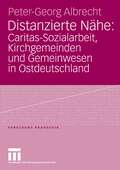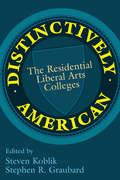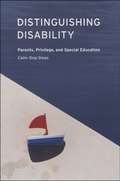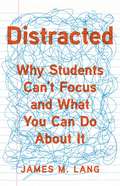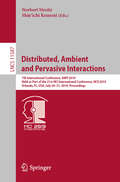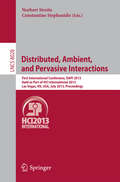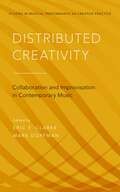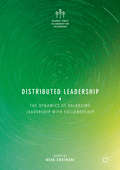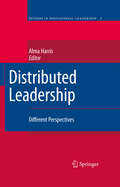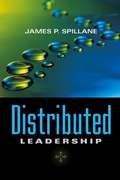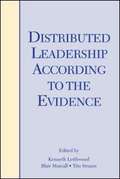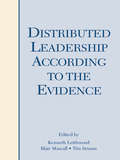- Table View
- List View
Distanzierte Nähe: Caritas-Sozialarbeit, Kirchgemeinden und Gemeinwesen in Ostdeutschland (Forschung Pädagogik)
by Peter-Georg AlbrechtCaritas-Sozialarbeit und Kirchgemeindeengagement gehören zusammen. Durch sie kommt 'Kirche zur Welt', wie es sich das Zweite Vatikanum, wie es aktuell die neue päpstliche Enzyklika 'Deus caritas est' wünscht. Die Studie belegt, dass Caritas-Sozialarbeiter und Kirchgemeindemitarbeiter nur bedingt kooperieren können und zeigt neue Perspektiven für die Zusammenarbeit auf.
Distinction, Exclusivity and Whiteness: Elite Nigerian Parents and the International Education Market
by Pere AylingThis book offers unique insights into elite Nigerian parents’ engagement with, and use of, the international secondary education market as they attempt to retain their social standing - via their children - under today’s shifting global conditions.Throughout, the book tackles two important, albeit uncomfortable questions: Why does whiteness hold the highest possible value in postcolonial societies such as Nigeria? And, more importantly, why do black people accept the hegemonic discourse that West/white is best?Combining the theoretical frameworks of Pierre Bourdieu and Frantz Fanon, the book reveals ‘Whiteness’ as a highly valuable form of cultural and symbolic capital that plays a crucial role in the formation of, and struggle for, elite status and distinction in modern-day Nigeria. Drawing on rare qualitative data sets along with postcolonial literatures, the book reveals how British whiteness is used by those working at and for British private schools in Nigeria (BPS-NIG) as an informal but powerful mechanism of ‘quality’ control, and in constructing the image of ‘world-class’ educational establishments.
The Distinctive College: Antioch, Reed, and Swathmore
by Burton R. ClarkThe factors contributing to the greatness of a first-rank liberal arts college are difficult to analyze. Hidden from view in the mysteries of tradition and institutional aura, the insistent questions remain: How has it been done? Can it still be done? In an intensive analysis of three highly regarded liberal arts colleges, Burton R. Clark uses a developmental approach to formal organization to seek out answers to these questions. The author begins with a presentation of the historical development of three colleges, Antioch, Reed, and Swarthmore. He describes in detail how broad institutional innovations were introduced and made to endure. He then carefully notes the unique events, special conditions, and unusual features that are the components of each institution's fabric. Each of the three narratives is guided by comparative categories, that produce analytical and theoretical insights into organizational development. From the above data Clark develops the concept of the "organizational saga" as the central ingredient in the making of the distinctive college. He explains this concept in terms of organizational role and mission, using the historical narratives of the first section to suggest the bases for the development of sagas. In its empirical findings and conceptual formulations, The Distinctive College, first published in 1970, has played an important role in the analysis and understanding of college culture in contemporary America. It is a study of leadership, as well as an examination of how values are realized in the everyday routine of participants in the life of educational organizations. It remains the premier sociological study of institution building in American higher education.
The Distinctive College: Antioch, Reed, and Swathmore
by Burton R. ClarkThe factors contributing to the greatness of a first-rank liberal arts college are difficult to analyze. Hidden from view in the mysteries of tradition and institutional aura, the insistent questions remain: How has it been done? Can it still be done? In an intensive analysis of three highly regarded liberal arts colleges, Burton R. Clark uses a developmental approach to formal organization to seek out answers to these questions. The author begins with a presentation of the historical development of three colleges, Antioch, Reed, and Swarthmore. He describes in detail how broad institutional innovations were introduced and made to endure. He then carefully notes the unique events, special conditions, and unusual features that are the components of each institution's fabric. Each of the three narratives is guided by comparative categories, that produce analytical and theoretical insights into organizational development. From the above data Clark develops the concept of the "organizational saga" as the central ingredient in the making of the distinctive college. He explains this concept in terms of organizational role and mission, using the historical narratives of the first section to suggest the bases for the development of sagas. In its empirical findings and conceptual formulations, The Distinctive College, first published in 1970, has played an important role in the analysis and understanding of college culture in contemporary America. It is a study of leadership, as well as an examination of how values are realized in the everyday routine of participants in the life of educational organizations. It remains the premier sociological study of institution building in American higher education.
Distinctively American: The Residential Liberal Arts Colleges
by Stephen R. GraubardThere is much change underway in American higher education. New technologies are challenging the teaching practices of yesterday, distance learning is lauded, and private firms offer to certify the educational credentials that businesses and others will deem satisfactory. In this new environment, America's liberal arts colleges propound a quite different set of values. Their continuing faith in the liberal arts--not as the nineteenth century chose to define them but as the twenty-first century will be obliged to reconsider them--is being tested.Distinctively American examines the American liberal arts college as an institution, from its role in the lives of students, to its value as a form of education. It explores the threats faced by liberal arts colleges as well as the transformative role, both positive and negative, information technology will play in their future development and survival. In the preface introducing the volume, Stephen Graubard examines the history of the American liberal arts colleges, from their early disdained reputations in comparison to European schools, to their slow rise to becoming "world-class universities."This important volume explores the triumphs and challenges of one segment of the American higher educational universe. It also addresses a larger question: What ought this country be teaching its young, the many millions who now throng its colleges and universities? Distinctively American is essential reading for all concerned with the future of higher education.
Distinctively American: The Residential Liberal Arts Colleges
by Steven Koblik Stephen R. GraubardThere is much change underway in American higher education. New technologies are challenging the teaching practices of yesterday, distance learning is lauded, and private firms offer to certify the educational credentials that businesses and others will deem satisfactory. In this new environment, America's liberal arts colleges propound a quite different set of values. Their continuing faith in the liberal arts--not as the nineteenth century chose to define them but as the twenty-first century will be obliged to reconsider them--is being tested.Distinctively American examines the American liberal arts college as an institution, from its role in the lives of students, to its value as a form of education. It explores the threats faced by liberal arts colleges as well as the transformative role, both positive and negative, information technology will play in their future development and survival. In the preface introducing the volume, Stephen Graubard examines the history of the American liberal arts colleges, from their early disdained reputations in comparison to European schools, to their slow rise to becoming "world-class universities."This important volume explores the triumphs and challenges of one segment of the American higher educational universe. It also addresses a larger question: What ought this country be teaching its young, the many millions who now throng its colleges and universities? Distinctively American is essential reading for all concerned with the future of higher education.
Distinguishing Disability: Parents, Privilege, and Special Education
by Colin Ong-DeanStudents in special education programs can have widely divergent experiences. For some, special education amounts to a dumping ground where schools unload their problem students, while for others, it provides access to services and accommodations that drastically improve chances of succeeding in school and beyond. Distinguishing Disability argues that this inequity in treatment is directly linked to the disparity in resources possessed by the students’ parents. Since the mid-1970s, federal law has empowered parents of public school children to intervene in virtually every aspect of the decision making involved in special education. However, Colin Ong-Dean reveals that this power is generally available only to those parents with the money, educational background, and confidence needed to make effective claims about their children’s disabilities and related needs. Ong-Dean documents this class divide by examining a wealth of evidence, including historic rates of learning disability diagnosis, court decisions, and advice literature for parents of disabled children. In an era of expanding special education enrollment, Distinguishing Disability is a timely analysis of the way this expansion has created new kinds of inequality.
Distinguishing Disability: Parents, Privilege, and Special Education
by Colin Ong-DeanStudents in special education programs can have widely divergent experiences. For some, special education amounts to a dumping ground where schools unload their problem students, while for others, it provides access to services and accommodations that drastically improve chances of succeeding in school and beyond. Distinguishing Disability argues that this inequity in treatment is directly linked to the disparity in resources possessed by the students’ parents. Since the mid-1970s, federal law has empowered parents of public school children to intervene in virtually every aspect of the decision making involved in special education. However, Colin Ong-Dean reveals that this power is generally available only to those parents with the money, educational background, and confidence needed to make effective claims about their children’s disabilities and related needs. Ong-Dean documents this class divide by examining a wealth of evidence, including historic rates of learning disability diagnosis, court decisions, and advice literature for parents of disabled children. In an era of expanding special education enrollment, Distinguishing Disability is a timely analysis of the way this expansion has created new kinds of inequality.
Distinguishing Disability: Parents, Privilege, and Special Education
by Colin Ong-DeanStudents in special education programs can have widely divergent experiences. For some, special education amounts to a dumping ground where schools unload their problem students, while for others, it provides access to services and accommodations that drastically improve chances of succeeding in school and beyond. Distinguishing Disability argues that this inequity in treatment is directly linked to the disparity in resources possessed by the students’ parents. Since the mid-1970s, federal law has empowered parents of public school children to intervene in virtually every aspect of the decision making involved in special education. However, Colin Ong-Dean reveals that this power is generally available only to those parents with the money, educational background, and confidence needed to make effective claims about their children’s disabilities and related needs. Ong-Dean documents this class divide by examining a wealth of evidence, including historic rates of learning disability diagnosis, court decisions, and advice literature for parents of disabled children. In an era of expanding special education enrollment, Distinguishing Disability is a timely analysis of the way this expansion has created new kinds of inequality.
Distinguishing Disability: Parents, Privilege, and Special Education
by Colin Ong-DeanStudents in special education programs can have widely divergent experiences. For some, special education amounts to a dumping ground where schools unload their problem students, while for others, it provides access to services and accommodations that drastically improve chances of succeeding in school and beyond. Distinguishing Disability argues that this inequity in treatment is directly linked to the disparity in resources possessed by the students’ parents. Since the mid-1970s, federal law has empowered parents of public school children to intervene in virtually every aspect of the decision making involved in special education. However, Colin Ong-Dean reveals that this power is generally available only to those parents with the money, educational background, and confidence needed to make effective claims about their children’s disabilities and related needs. Ong-Dean documents this class divide by examining a wealth of evidence, including historic rates of learning disability diagnosis, court decisions, and advice literature for parents of disabled children. In an era of expanding special education enrollment, Distinguishing Disability is a timely analysis of the way this expansion has created new kinds of inequality.
Distinguishing Disability: Parents, Privilege, and Special Education
by Colin Ong-DeanStudents in special education programs can have widely divergent experiences. For some, special education amounts to a dumping ground where schools unload their problem students, while for others, it provides access to services and accommodations that drastically improve chances of succeeding in school and beyond. Distinguishing Disability argues that this inequity in treatment is directly linked to the disparity in resources possessed by the students’ parents. Since the mid-1970s, federal law has empowered parents of public school children to intervene in virtually every aspect of the decision making involved in special education. However, Colin Ong-Dean reveals that this power is generally available only to those parents with the money, educational background, and confidence needed to make effective claims about their children’s disabilities and related needs. Ong-Dean documents this class divide by examining a wealth of evidence, including historic rates of learning disability diagnosis, court decisions, and advice literature for parents of disabled children. In an era of expanding special education enrollment, Distinguishing Disability is a timely analysis of the way this expansion has created new kinds of inequality.
Distinguishing Disability: Parents, Privilege, and Special Education
by Colin Ong-DeanStudents in special education programs can have widely divergent experiences. For some, special education amounts to a dumping ground where schools unload their problem students, while for others, it provides access to services and accommodations that drastically improve chances of succeeding in school and beyond. Distinguishing Disability argues that this inequity in treatment is directly linked to the disparity in resources possessed by the students’ parents. Since the mid-1970s, federal law has empowered parents of public school children to intervene in virtually every aspect of the decision making involved in special education. However, Colin Ong-Dean reveals that this power is generally available only to those parents with the money, educational background, and confidence needed to make effective claims about their children’s disabilities and related needs. Ong-Dean documents this class divide by examining a wealth of evidence, including historic rates of learning disability diagnosis, court decisions, and advice literature for parents of disabled children. In an era of expanding special education enrollment, Distinguishing Disability is a timely analysis of the way this expansion has created new kinds of inequality.
Distracted: Why Students Can't Focus and What You Can Do About It
by James M. LangKeeping students focused can be difficult in a world filled with distractions -- which is why a renowned educator created a scientific solution to one of every teacher's biggest problems.Why is it so hard to get students to pay attention? Conventional wisdom blames iPhones, insisting that access to technology has ruined students' ability to focus. The logical response is to ban electronics in class. But acclaimed educator James M. Lang argues that this solution obscures a deeper problem: how we teach is often at odds with how students learn. Classrooms are designed to force students into long periods of intense focus, but emerging science reveals that the brain is wired for distraction. We learn best when able to actively seek and synthesize new information. In Distracted, Lang rethinks the practice of teaching, revealing how educators can structure their classrooms less as distraction-free zones and more as environments where they can actively cultivate their students' attention. Brimming with ideas and grounded in new research, Distracted offers an innovative plan for the most important lesson of all: how to learn.
Distraction Trap, The: How to Focus in a Digital World
by Frances BoothIf you're worried that you're losing the power to concentrate The Distraction Trap can help. Learn how you can easily release your life from the steely grip of modern technology where you're always available and always connected. Discover how you can radically boost your productivity by keeping your whole brain and both eyes on the task in hand. You may think you can do ten things at once, with a scattered thinking approach and expect to do everything well and on time. Well, you can't. The Distraction Trap will empower you to focus and prioritise, switch off your email, say 'no' to social media ruling your life and help you rediscover your lost powers of concentration. Your campaign to reclaim your life starts here and now!
Distributed, Ambient and Pervasive Interactions: 7th International Conference, DAPI 2019, Held as Part of the 21st HCI International Conference, HCII 2019, Orlando, FL, USA, July 26–31, 2019, Proceedings (Lecture Notes in Computer Science #11587)
by Norbert Streitz Shin’ichi KonomiThis book constitutes the refereed proceedings of the 7th International Conference on Distributed, Ambient and Pervasive Interactions, DAPI 2019, held as part of the 21st International Conference on Human-Computer Interaction, HCII 2019, in Orlando, Florida, USA, in July 2019. A total of 1274 papers and 209 posters have been accepted for publication in the HCII 2019 proceedings from a total of 5029 submissions. The 36 papers included in this volume were organized in topical sections on IoT and big data; smart cities and built environments; perception and emotion in DAPI; and DAPI for health and learning.
Distributed, Ambient, and Pervasive Interactions: First International Conference, DAPI 2013, Held as Part of HCI International 2013, Las Vegas, NV, USA, July 21-26, 2013. Proceedings (Lecture Notes in Computer Science #8028)
by Norbert Streitz Constantine StephanidisThis book constitutes the refereed proceedings of the 5th International Conference on Distributed, Ambient and Pervasive Interactions, DAPI 2013, held as part of the 15th International Conference on Human-Computer Interaction, HCII 2013, held in Las Vegas, USA in July 2013, jointly with 12 other thematically similar conferences. The total of 1666 papers and 303 posters presented at the HCII 2013 conferences was carefully reviewed and selected from 5210 submissions. These papers address the latest research and development efforts and highlight the human aspects of design and use of computing systems. The papers accepted for presentation thoroughly cover the entire field of human-computer interaction, addressing major advances in knowledge and effective use of computers in a variety of application areas. The total of 54 contributions was carefully reviewed and selected for inclusion in the DAPI proceedings. The papers are organized in the following topical sections: natural interaction; context-awareness in smart and intelligent environments; design and evaluation of smart and intelligent environments; smart cities; multi-user, group and collaborative interaction; smart everyday living and working environments.
Distributed Creativity: Collaboration and Improvisation in Contemporary Music (Studies in Musical Perf as Creative Prac)
by Eric F. Clarke and Mark DoffmanCreative practice in music, particularly in traditional concert culture, is commonly understood in terms of a rather stark division of labour between composer and performer. But this overlooks the distributed and interactive nature of the creative processes on which so much contemporary music depends. The incorporation of two features-improvisation and collaboration-into much contemporary music suggests that the received view of the relationship between composition and performance requires reassessment. Improvisation and collaborative working practices blur the composition/performance divide and, in doing so, provide important new perspectives on the forms of distributed creativity that play a central part in much contemporary music. Distributed Creativity: Collaboration and Improvisation in Contemporary Music explores the different ways in which collaboration and improvisation enable and constrain creative processes. Thirteen chapters and twelve shorter Interventions offer a range of perspectives on distributed creativity in music, on composer/performer collaborations and on contemporary improvisation practices. The chapters provide substantial discussions of a variety of conceptual frameworks and particular projects, while the Interventions present more informal contributions from a variety of practitioners (performers, composers, improvisers), giving insights into the pleasures and perils of working creatively in collaborative and improvised ways.
Distributed Creativity: Collaboration and Improvisation in Contemporary Music (Studies in Musical Perf as Creative Prac)
Creative practice in music, particularly in traditional concert culture, is commonly understood in terms of a rather stark division of labour between composer and performer. But this overlooks the distributed and interactive nature of the creative processes on which so much contemporary music depends. The incorporation of two features-improvisation and collaboration-into much contemporary music suggests that the received view of the relationship between composition and performance requires reassessment. Improvisation and collaborative working practices blur the composition/performance divide and, in doing so, provide important new perspectives on the forms of distributed creativity that play a central part in much contemporary music. Distributed Creativity: Collaboration and Improvisation in Contemporary Music explores the different ways in which collaboration and improvisation enable and constrain creative processes. Thirteen chapters and twelve shorter Interventions offer a range of perspectives on distributed creativity in music, on composer/performer collaborations and on contemporary improvisation practices. The chapters provide substantial discussions of a variety of conceptual frameworks and particular projects, while the Interventions present more informal contributions from a variety of practitioners (performers, composers, improvisers), giving insights into the pleasures and perils of working creatively in collaborative and improvised ways.
Distributed Leadership: The Dynamics of Balancing Leadership with Followership
by Neha ChatwaniAddressing the area of shared leadership, also known as collective or distributed leadership, this edited book embraces the underlying idea that leadership is a dynamic process that intersects closely with followership. While some authors present rigorously researched qualitative and quantitative case studies that investigate the dynamics of followership in distributive leadership in terms of collective decision-making, leadership identity, roles and demographic composition of groups in a variety of settings, other authors take a critical look at distributed leadership models by viewing them through the lens of nature and ecosystems as well as human development processes. The chapters aim to inspire readers to challenge the current definition of leadership and explore more inclusive and holistic paradigms. Distributed Leadership provides a comprehensive and constructive contribution to the field of leadership and will be an essential read for academics and scholar-practitioners interested in business management.
Distributed Leadership: The Dynamics of Balancing Leadership with Followership
by Neha ChatwaniAddressing the area of shared leadership, also known as collective or distributed leadership, this edited book embraces the underlying idea that leadership is a dynamic process that intersects closely with followership. While some authors present rigorously researched qualitative and quantitative case studies that investigate the dynamics of followership in distributive leadership in terms of collective decision-making, leadership identity, roles and demographic composition of groups in a variety of settings, other authors take a critical look at distributed leadership models by viewing them through the lens of nature and ecosystems as well as human development processes. The chapters aim to inspire readers to challenge the current definition of leadership and explore more inclusive and holistic paradigms. Distributed Leadership provides a comprehensive and constructive contribution to the field of leadership and will be an essential read for academics and scholar-practitioners interested in business management.
Distributed Leadership: Different Perspectives (Studies in Educational Leadership #7)
by Alma HarrisAlma Harris The ?eld of school leadership is currently preoccupied with the idea of distributed leadership. Few ideas, it seems, have provoked as much attention, debate and c- troversy. Whatever your position on distributed leadership, and you cannot fail to have one, it is irrefutable that distributed leadership has become the leadership idea of the moment. Yet, it is an idea that can be traced back as far as the mid 20s and possibly earlier. So why the interest? Part of the answer can be found in a move away from theorizing and empirical enquiry focused on the single leader. This shift has undoubtedly been fuelled by structural changes, within schools and across school systems that have resulted in - ternative models or forms of leadership practice. Evidence highlights how those - cupying formal leadership positions are increasingly recognizing the limitations of existing structural arrangements to secure organizational growth and transformation (Fullan et al. , 2007; Harris et al. , 2008; Chapman et al. , 2008). As a consequence, many heads and principals are actively restructuring, realigning and redesigning leadership practice in their school (Harris, 2008). While the terminology to describe such changes varies, the core principle is one of extending or sharing leadership practice. While scholars have long argued for the need to move beyond those at the top of organizations in order to examine leadership (Barnard, 1968; Katz and Kahn, 1966) until relatively recently, much of the school leadership literature has tended tofocusupontheheadortheprincipal.
Distributed Leadership (Jossey-Bass Leadership Library in Education #4)
by James P. SpillaneJames Spillane, the leading expert in Distributed Leadership, shows how leadership happens in everyday practices in schools, through formal routines and informal interactions. He examines the distribution of leadership among administrators, specialists, and teachers in the school, and explains the ways in which leadership practice is stretched over leaders, followers, and aspects of the situation, including routines and tools of various sorts in the organization such as memos, scheduling procedures, and evaluation protocols. This book is a volume in the Jossey-Bass Leadership Library in Education—a series designed to meet the demand for new ideas and insights about leadership in schools.
Distributed Leadership According To The Evidence
by Kenneth Leithwood Blair Mascall Tiiu StraussAlthough not new, the concept of distributed (shared) leadership has re-emerged in recent years as one highly promising response to the complex challenges currently faced by schools. Responding productively to these challenges far exceeds the capacities of any individual leader. If schools are to flourish in the future, they will need to enlist the collective expertise of many more of their members and stakeholders than they have in the past. The purpose of this volume is to both present and synthesize the best available evidence about the nature, causes, and effects of distributed school leadership. The book also clarifies common misunderstandings about distributed leadership and identifies promising implications for practice and for future research. Key features include. . . Expertise - Written by the most active and widely respected scholars engaged in research on distributed leadership, the book encompasses the very latest knowledge about the nature, causes and consequences of such leadership in schools. Comparative Models - The book compares various approaches to distributed leadership and examines the conditions under which some approaches may be better than others in improving schools. Evidence-Based - Much of the popularity of distributed leadership is rooted in expectations unsupported by systematic empirical evidence. Virtually all of the available evidence about distributed approach to leadership can be found in this book. This book is appropriate for researchers studying school leadership, instructors and students in graduate-level school leadership courses and practicing administrators at the district and building level. 9780805864229 9781410618573
Distributed Leadership According to the Evidence
by Kenneth Leithwood Blair Mascall Tiiu StraussAlthough not new, the concept of distributed (shared) leadership has re-emerged in recent years as one highly promising response to the complex challenges currently faced by schools. Responding productively to these challenges far exceeds the capacities of any individual leader. If schools are to flourish in the future, they will need to enlist the collective expertise of many more of their members and stakeholders than they have in the past. The purpose of this volume is to both present and synthesize the best available evidence about the nature, causes, and effects of distributed school leadership. The book also clarifies common misunderstandings about distributed leadership and identifies promising implications for practice and for future research. Key features include… Expertise – Written by the most active and widely respected scholars engaged in research on distributed leadership, the book encompasses the very latest knowledge about the nature, causes and consequences of such leadership in schools. Comparative Models – The book compares various approaches to distributed leadership and examines the conditions under which some approaches may be better than others in improving schools. Evidence-Based – Much of the popularity of distributed leadership is rooted in expectations unsupported by systematic empirical evidence. Virtually all of the available evidence about distributed approach to leadership can be found in this book. This book is appropriate for researchers studying school leadership, instructors and students in graduate-level school leadership courses and practicing administrators at the district and building level.
Distributed Leadership According to the Evidence
by Kenneth Leithwood Blair Mascall Tiiu StraussAlthough not new, the concept of distributed (shared) leadership has re-emerged in recent years as one highly promising response to the complex challenges currently faced by schools. Responding productively to these challenges far exceeds the capacities of any individual leader. If schools are to flourish in the future, they will need to enlist the collective expertise of many more of their members and stakeholders than they have in the past. The purpose of this volume is to both present and synthesize the best available evidence about the nature, causes, and effects of distributed school leadership. The book also clarifies common misunderstandings about distributed leadership and identifies promising implications for practice and for future research. Key features include… Expertise – Written by the most active and widely respected scholars engaged in research on distributed leadership, the book encompasses the very latest knowledge about the nature, causes and consequences of such leadership in schools. Comparative Models – The book compares various approaches to distributed leadership and examines the conditions under which some approaches may be better than others in improving schools. Evidence-Based – Much of the popularity of distributed leadership is rooted in expectations unsupported by systematic empirical evidence. Virtually all of the available evidence about distributed approach to leadership can be found in this book. This book is appropriate for researchers studying school leadership, instructors and students in graduate-level school leadership courses and practicing administrators at the district and building level.
